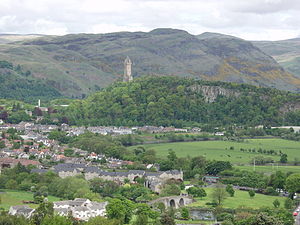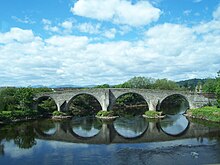Battle of Stirling Bridge
| date | September 11, 1297 |
|---|---|
| place | Stirling |
| output | Scottish victory |
| Parties to the conflict | |
|---|---|
| Commander | |
| Troop strength | |
| between 5000 and 6000 men, 180 of them men-at-arms | between 5,800 and 10,000 men (including approx. 300–350 men-at-arms) |
| losses | |
|
high |
at least 1,650 men, including about 100 men-at-arms |
Battles of the First Scottish War of Independence
Berwick - Dunbar - Stirling Bridge - Falkirk - Roslin - Stirling Castle - Methven - Dalry - Glen Trool - Loudoun Hill - Inverurie - Brander - Perth - Bannockburn - Berwick - Berwick - Myton - Byland - Weardale
Battles of the Second Scottish Revolutionary War
Kinghorn - Dupplin Moor - Annan - Berwick - Halidon Hill - Boroughmuir - Culblean - Neville's Cross
The Battle of Stirling Bridge was a battle of the Scottish Wars of Independence . On September 11, 1297, the Scottish troops under Andrew de Moray and his subordinate William Wallace won the bridge over the Forth near Stirling . The English under John de Warenne suffered a heavy defeat.
prehistory
In the war between England and Scotland , the English King Edward I defeated the Scots in a short campaign in 1296. The Scottish King Edward Balliol was forced to abdicate and the conquered empire was placed under English administration. The English king then withdrew to England to prepare a campaign to Flanders in the war against France . The king appointed Earl Warenne , who had defeated the Scottish army in the Battle of Dunbar in 1296, as its governor . Warenne left the administration of Scotland largely to officials, from whom the Treasurer Hugh Cressingham was able to gain great influence. The Scottish resistance seemed broken, especially since numerous Scottish magnates were still in English captivity or took part in the campaign of the English king. Nevertheless, in the spring of 1297 there were partly spontaneous rebellions against English rule in large parts of Scotland. The leader of these rebellions was William Wallace, who came from a knightly family in southern Scotland, and Andrew de Moray, a member of a noble family in northern Scotland. There is no reliable information about the course of the uprising, but British rule quickly collapsed in large parts of Scotland due to rebellion. Presumably towards the end of August 1297, Wallace and Moray combined their troops.
Deployment of the English and Scottish armies
After long hesitation, Warenne raised an army that summer to put down the uprising. From Berwick he moved with Cressingham to the strategically important Stirling Castle on the south bank of the Forth. There a narrow wooden bridge formed the easternmost crossing over the river at the time. The English army consisted of a handsome force of mounted men-at-arms and mostly Welsh archers and foot soldiers. According to Cressingham, in July it consisted of 300 men-at-arms and 10,000 foot soldiers. This number was probably not reached, however, and desertions had caused the number of foot soldiers to have fallen to between 5,500 and 6,000 by September. Cressingham is even said to have rejected the offer from Henry Percy , who wanted to strengthen the army with 300 more men-at-arms and 8,000 foot soldiers. He thought the army was sufficient and turned down Percy's reinforcements in order to save costs. Wallace and Moray's contingent consisted of a small, 180-strong cavalry troop, mostly largely untrained, unarmored and lightly armed peasants. Moray's contingent of 4,000 to 5,000 men is said to have made up the majority of the Scottish army, while Wallace's force was only about 1,000 men strong. Wallace and Moray had set up their troops on the south slope of Abbey Craig , a range of hills on the north bank of the Forth, partly steeply sloping. The Scottish army was about 1.5 km north of the narrow bridge below Stirling Castle. From the north end of the bridge to the beginning of Abbey Craig, a road ran over a causeway through meadows and cornfields, bounded on both sides by the meandering river. The terrain was not swampy, but because of the soft ground it was not suitable for a horseback attack. Warenne reached Stirling with his army in early September, where he was joined by the allegedly loyal Scottish nobles James Stewart and the Earl of Lennox . On September 10th, Stewart and Lennox rode away again to fetch reinforcements and to convince the Scots to surrender.
Course of the battle
On the morning of September 11th, English foot soldiers crossed the bridge, but were ordered back because Earl Warenne is said to have overslept. When he was finally ready to leave, the foot soldiers were sent back across the bridge. Now Stewart and Lennox have returned with 40 Scottish men-at-arms. They first met plundering English soldiers, whereupon they were confronted by Stewart and Lennox. An English soldier was killed in the skirmish that followed, which led to rumors in the English army that Stewart and Lennox would betray them. Warenne was finally able to end the banter. Now that Stewart and Lennox had returned to the main English army, the foot soldiers were called back again, as Warenne hoped that Stewart and Lennox would come with the news that the Scots would surrender. However, Stewart and Lennox reported that they couldn't even get their own vassals to surrender. Warenne then sent two Dominicans to Wallace who asked him if the Scots wanted to surrender. Wallace harshly denied this. The English army then prepared for battle. The knight Sir Richard Lundie , who fought on the English side but came from Scotland, suggested crossing the river with part of the army through the broad ford to the west at Drip in order to be able to fall in the back of the Scots. This was refused by Cressingham on the grounds that after the morning delays they couldn't waste any more time. Warenne then gave the order to cross the bridge. When the English vanguard under the command of Cressingham and Marmaduke of Thwing had crossed the bridge with about 150 men-at-arms and about 1,800 foot soldiers, Moray and Wallace gave the order to attack. The Scottish foot soldiers stormed down the hills and ran across the meadows towards the dam. A troop fighting as Schiltron managed to occupy the bridge and thus divide the English army. The English soldiers who were already standing on the north bank of the Forth received no further reinforcements. They could not line up for battle on the terrain that was unfavorable for them and were overwhelmed by the Scots. The battle turned into a massacre. Few of the English men-at-arms who had crossed the bridge managed to escape, including Marmaduke of Thwing. About 300 of the unarmored foot soldiers were also able to escape through the river. Cressingham, who wore armor despite his clerical status, was killed. The body of the hated treasurer was desecrated by the Scots. The Scots also suffered heavy losses, including the seriously wounded Moray. He probably died of his wounds about two months later. Warenne had stayed on the south bank of the bridge. When he realized that the battle was lost, he had the bridge demolished and left the English soldiers on the north bank to their fate. Since the commander and much of the garrison of Stirling Castle had belonged to the English vanguard and had died in the battle, he commissioned Marmaduke of Thwing and Fulk Fitz Warin to defend the castle. Then he is said to have ridden wildly to Berwick. The remaining English army then also fled south. The English army's baggage train tried to escape via the road to Falkirk . In a swampy plain, criss-crossed by several streams, the baggage train was attacked by the soldiers of Stewart and Lennox, who now openly switched sides. All baggage wagons and pack horses of the English army are said to have been captured by the Scots.
consequences
The Battle of Stirling Bridge was very important to the war. It was a heavy but not a decisive defeat for the English. It was a double shock for them that their knights had been defeated by foot soldiers and, moreover, by Scottish foot soldiers. In contrast to the Battle of Dunbar, Earl Warenne had shown no tactical skill at Stirling. For the Scots, however, the victory was a triumph. Wallace took advantage of the English defeat and led a raid into northern England in October. Before the end of the year he was elected to the Guardian of Scotland mainly because of the victory at Stirling Bridge , with which he officially took over the military and political leadership of the uprising. Stirling Castle was besieged by the Scots, whereupon the crew had to surrender in early 1298. The English king, who was campaigning in Flanders at the time of the defeat, but led a new English army to Scotland the next year and decisively defeated Wallace in the Battle of Falkirk .
In the 19th century, the Wallace Monument was built on Abbey Craig to commemorate the victory .
literature
- GWS Barrow : Robert Bruce and the Community of the Realm of Scotland. 4th edition, Edinburgh 2005, ISBN 0-7486-2022-2 .
- Chris Brown: William Wallace. The True Story of Braveheart. Stroud 2005, ISBN 0-7524-3432-2 .
- Stuart Reid: Battles of the Scottish Lowlands. Barnsley 2004, ISBN 1-8441-5078-X .
Web links
- Battlefield entry . In: Historic Scotland .
- Battlefields of Britain: BATTLE OF STIRLING BRIDGE (1297)
Individual evidence
- ^ A b Geoffrey WS Barrow: Robert Bruce and the Community of the Realm of Scotland . Eyre & Spottiswoode, London 1965, p. 123.
- ^ Battlefield entry . In: Historic Scotland .
- ^ A b c Geoffrey WS Barrow: Robert Bruce and the Community of the Realm of Scotland . Eyre & Spottiswoode, London 1965, p. 124.
- ^ A b c Geoffrey WS Barrow: Robert Bruce and the Community of the Realm of Scotland . Eyre & Spottiswoode, London 1965, p. 125.
- ^ A b Geoffrey WS Barrow: Robert Bruce and the Community of the Realm of Scotland . Eyre & Spottiswoode, London 1965, p. 126.
Coordinates: 56 ° 7 ′ 43.1 ″ N , 3 ° 56 ′ 12.5 ″ W.

